Who is Lord Vishnu?
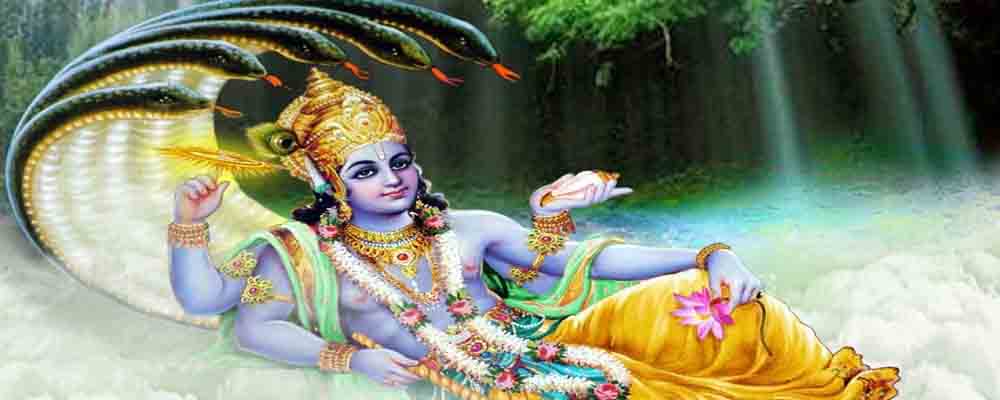
Vishnu is considered the Supreme God of Vaishnavism, which is one of the largest denominations in Hinduism. He is also one of the three supreme deities in Hinduism, along with Brahma and Shiva. Vishnu is also known by the names Narayana and Hari.
As the “Preserver or the Protector” in the Trimurti, Vishnu is one of the five primary forms of God in the Smarta tradition. He is responsible for maintaining the balance and order of the universe, and he represents Sattvaguna, the quality of goodness, purity, and enlightenment.
Vishnu is a complex character, and he is often depicted with four arms, each holding different objects that symbolize his various powers. He is also known for his avatars, which are incarnations of Vishnu that take on human form to restore balance and harmony to the universe. Some of his most famous avatars include Rama, Krishna, and Buddha.
The name Vishnu comes from the Sanskrit word “vish,” which means “to pervade” or “to enter into everything.” This reflects his dual nature as both the transcendent and immanent reality of the universe. He is the inner cause and power that sustains and maintains all things.
Overall, Vishnu plays a crucial role in Hinduism as the Preserver and Protector of the universe. He represents goodness, balance, and enlightenment, and his avatars continue to inspire people around the world to this day.
Lord Vishnu Family
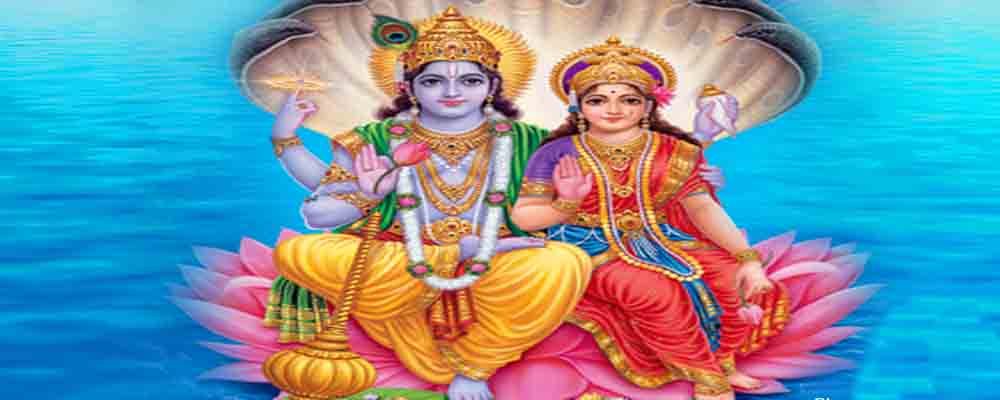
Lord Vishnu is often depicted with his consort, Goddess Lakshmi, who is considered the Goddess of Wealth and Fortune. She is believed to have been created by the churning of the cosmic ocean and is considered to be an important figure in Hinduism.
According to Hindu mythology, Lord Vishnu and Goddess Lakshmi are believed to be eternal companions, and their marriage is considered one of the most important events in the universe. In many Hindu traditions, it is believed that worshipping Lord Vishnu and Goddess Lakshmi together can bring wealth, prosperity, and good fortune into one’s life.
In addition to his consort, Lord Vishnu is also believed to have several children, including some of his famous avatars. For example, Lord Rama, who is believed to be the seventh avatar of Lord Vishnu, is often depicted with his wife Sita and his loyal brother Lakshmana. Similarly, Lord Krishna, another famous avatar of Lord Vishnu, is often depicted with his consort Radha and his close friends and companions, including Arjuna and Balarama.
Overall, Lord Vishnu’s family plays an important role in Hindu mythology, with his consort Goddess Lakshmi and his various avatars and companions representing important values and virtues in Hinduism.
Lord Vishnu Iconography
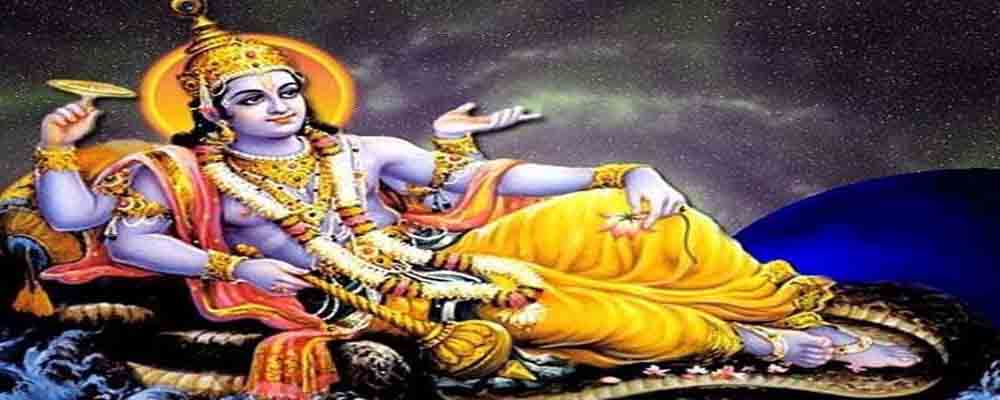
Lord Vishnu is typically depicted with dark blue skin, representing the color of a dark cloud, which is associated with his cosmic dimensions and his connection with the Vedic gods of rain and thunder. He is often portrayed with four arms, which symbolize his strength and power. In his four hands, he holds a conch, a discus, a mace, and a lotus.
The conch represents the five elements, the sound of AUM, the goddess Lakshmi, purity, and perfection. The discus is a powerful weapon used by Lord Vishnu to destroy evil and protect righteousness. It represents the light-bearing sun, which illuminates and removes darkness, and higher consciousness that destroys illusions. The mace represents the power of knowledge, while the lotus symbolizes beauty, harmony, purity, the water element, creation, and self-realization.
Lord Vishnu is often depicted standing or resting on the coils of the thousand-hooded serpent, Adishesha, who represents time, diversity, desire, and illusion. His consort, Goddess Lakshmi, who is the goddess of wealth and prosperity, often attends to him.
One of the most recognizable features of Lord Vishnu is his necklace made of the Kaustubha gem that rests on his left chest. He also wears a garland of flowers and gems called Vaijayanti. In Hindu mythology, Lord Vishnu is said to reside in the milky waters of Vaikunth, representing bliss and consciousness.
In addition to Lord Vishnu, two other deities are often found in Vaishnava temples. Garuda, the mighty bird vehicle of Lord Vishnu, is a minor deity who is usually depicted as having the head, wings, and talons of an eagle and the body of a human. Hanuman, the monkey god, is also a common sight in Vishnu temples, especially in the South. In Hindu mythology, Hanuman is known for his strength, wisdom, and devotion.
Overall, Lord Vishnu’s iconography is rich in symbolism and is a testament to his power, strength, and role as a protector and preserver in Hindu mythology.
Lord Vishnu Mantra
“Om Namo Narayanaya. Om Namo Bhagavate Vasudevaya”
(ॐ नमोः नारायणाय. ॐ नमोः भगवते वासुदेवाय)
Dashavatara – 10 Avatars of Lord Vishnu
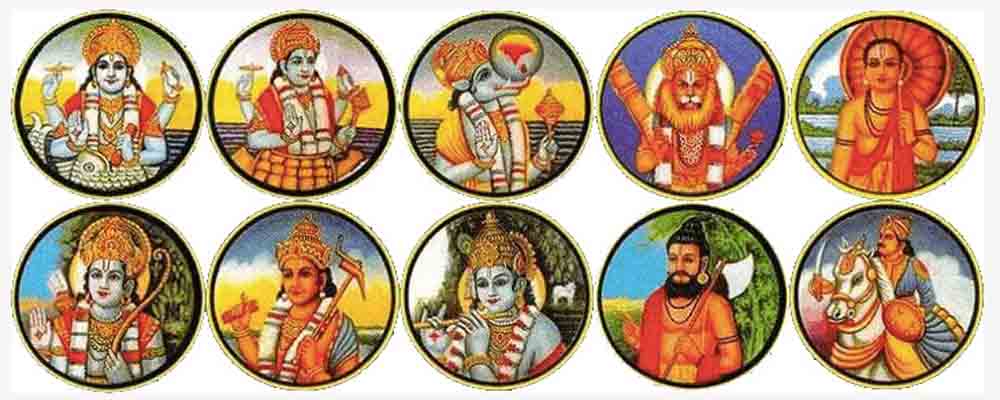
Following is an overview of the 10 principal avatars of Vishnu:
- Matsya Avatar (Fish incarnation): In this form, Vishnu saved Saint Vaivaswata, similar to the biblical story of Noah and the ark.
- Kurma Avatar (Turtle incarnation): During the churning of the ocean, Vishnu took the form of a turtle and offered his back as a pivot on which to rest Mount Mandara, which was used as a churning stick by the gods and demons.
- Varaha Avatar (Boar incarnation): In this form, Vishnu killed the demon Hiranyaksha, who had stolen the Vedas and hidden the earth at the bottom of the ocean.
- Narasimha Avatar (Half-man, half-lion incarnation): Vishnu took this form to kill the demon Hiranyakashipu, who had been granted immunity from attacks by man, beast, or god.
- Vamana Avatar (Dwarf incarnation): In this form, Vishnu defeated the demon king Bali, who had gained dominion over the Earth and the heavens.
- Parashurama Avatar: Vishnu took this form to kill King Kartavirya, who had stolen the holy cow Kamadhenu.
- Lord Rama Avatar: Vishnu took this form to kill the demon king Ravana, who had abducted Sita.
- Lord Krishna Avatar: Vishnu took this form to kill the tyrannical King of Mathura, Kansa, who was the son of a demon.
- Buddha Avatar: In this form, Vishnu incarnated to remove suffering from the world.
- Kalki Avatar: This is the tenth and final incarnation of Vishnu and is yet to come at the end of the Kaliyuga, which is the present age of decline. In this form, Vishnu will appear on Earth, riding a white horse named Kalki.
Overall, Lord Vishnu’s ten principal avatars represent important stories and lessons in Hindu mythology and are celebrated by Hindus around the world.
The Famous Temples of Lord Vishnu
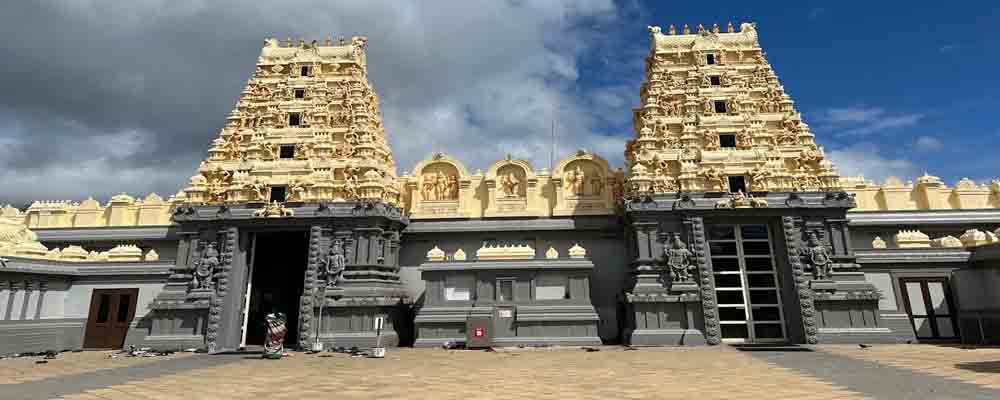
Lord Vishnu is widely worshiped across India as one of the five primary gods in Hinduism. As the preserver of the universe, he is often depicted with his consort, Goddess Lakshmi, the goddess of wealth. In Hindu mythology, Lord Vishnu has taken many avatars to save humanity from threats posed by demons.
India is home to many grand and wealthy temples dedicated to Lord Vishnu and his incarnations. Here a list of must-visit temples of Lord Vishnu in India:
Badrinath Temple: Located in the picturesque Himalayan region of Uttarakhand, this temple is one of the four sacred shrines in Hinduism. It is dedicated to Lord Badrinath, another form of Lord Vishnu. The temple is believed to be one of the holiest sites in Hinduism and is visited by millions of devotees every year.
Jagannath Puri Temple: This temple in Odisha is dedicated to Lord Jagannath, another form of Lord Vishnu. The temple is famous for its annual Rath Yatra or chariot festival, which attracts thousands of devotees from all over the world. The temple complex is also home to many other smaller shrines and temples.
Dwarkadhish Temple: Located in the city of Dwarka in Gujarat, this temple is dedicated to Lord Krishna, an incarnation of Lord Vishnu. The temple is believed to have been built over 2,500 years ago and is considered one of the holiest sites in Hinduism. The temple is also home to many other shrines and temples dedicated to other Hindu deities.
Kesava Deo Temple: Located in Mathura, this temple is dedicated to Lord Krishna. It is believed to be one of the oldest temples in India and is considered a very sacred site for Hindus. The temple is also home to many other smaller shrines and temples.
Tirumala Venkateswara Temple: Located in the town of Tirupati in Andhra Pradesh, this temple is dedicated to Lord Venkateswara, another form of Lord Vishnu. The temple is one of the most visited temples in India and is known for its grandeur and beauty. The temple is also famous for its prasadam or holy food, which is served to devotees.
Ranganathaswamy Temple: This temple in Srirangam, Tamil Nadu, is dedicated to Lord Ranganatha, another form of Lord Vishnu. It is one of the largest temple complexes in India and is known for its rich history and cultural significance. The temple is also home to many other smaller shrines and temples.
Shree Padmanabhaswamy Temple: Located in Thiruvananthapuram, Kerala, this temple is dedicated to Lord Vishnu in his form as Lord Padmanabha. The temple is famous for its intricate architecture and is considered one of the wealthiest temples in India.
These temples are considered very sacred by Hindus and are visited by millions of devotees every year. They are also known for their grandeur, beauty, and historical significance.
Lord Vishnu Festival and Vrats
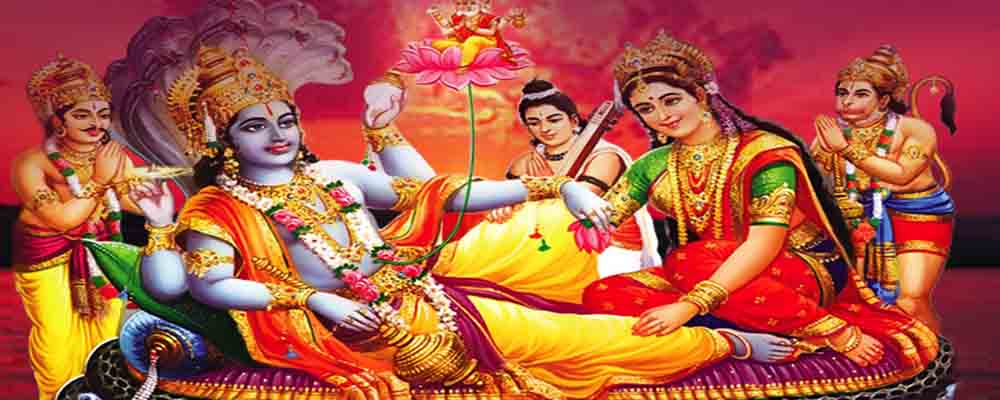
Lord Vishnu is a highly revered god in Hinduism, and several festivals and Vrats (fasting) are celebrated in his honor throughout the year. These celebrations signify the triumphs of Lord Vishnu and his many incarnations.
Chaturmasa is a period of social dormancy and prayer during the four rainy months every year when Vishnu rests on Anant-Sesha. This period starts on Shayani-ekadashi, the eleventh day of the waxing moon in the month of Ashadha and ends four months later on Prabodhini-ekadashi, the eleventh day of the waxing moon in the month of Kartika.
Diwali is the festival of lights and is celebrated on the new moon night that comes after Dussera. Lakshmi, the consort of Lord Vishnu, is worshipped on this day, and lamps are lit to welcome her into homes. It also marks the return of Shri Rama to the kingdom of Ayodhya after 14 years in the forest. Devotees express their joy by lighting lamps and bursting crackers to mark the end of Chaturmasa and to herald the return of Vishnu to drive away demons and all evil.
Gokul-Ashtami celebrates the auspicious descent of Vishnu upon the earth as Krishna. This festival is celebrated on the eighth day of the waning moon of Shravana. Devotees gather in large numbers in temples and sing bhajans in his praise. Maha prasad is distributed, and Laddo Gopal is placed in cradles in temples.
Tulsi-Vivaha marks the beginning of the Hindu marriage season. On the twelfth day of the waxing moon in the month of Kartika, Vishnu renews his pact of protecting the earth by ceremonially marrying the earth-goddess, who is represented by the Tulsi plant.
Akshaya-Tritiya is celebrated on the third day of the bright half of Vaishaka when Renuka gave birth to Parashurama, the sixth incarnation of Lord Vishnu. People buy gold on this day with the knowledge that the lord will protect their wealth from thieves.
Makara-Sankranti is celebrated on the 14th of January each year, marking the beginning of the northward journey of the Sun God, Surya-Narayana, into the house of Makara, the abode of Madana, the lord of love. It also marks the winter harvest and is celebrated as Lohri in North India and Pongal in the South India.
Holi is celebrated during the month of Phalguna, which marks the end of winter and the beginning of spring. It is a festival of love, joy, colors, and excitement welcoming the Lord of pleasure, Madana. On the eve of Holi, great bonfires are lit to mark the end of the female demon Holika.
Dattatreya Jayanti is celebrated on the full moon day in the month of Margashisha, marking the day when Datta, the great yogi and tantric, was born to the chaste Anasuya, wife of the sage Atri. Datta embodies the spirit of Vishnu and is worshipped as a Divine Teacher.
Narali Poornima is a festival celebrated on the full moon night of the Hindu month of Shravana. On this day, fishermen offer coconuts to the Sea God Varuna to express gratitude for holding the bridge that allowed Lord Rama to rescue his wife Sita from the demon king Ravana. This day also marks the end of the monsoon season, enabling fishermen to resume their work. In some regions of India, farmers worship oxen to commemorate the birth of Balrama, the elder brother of Lord Krishna, who is considered the lord of farmers. On this day, sisters tie sacred threads on the wrists of their brothers and seek their blessings.
Dev Diwali is celebrated on the full moon day following Tulsi Vivah. It commemorates the descent of Lord Vishnu on earth as Matsya, the divine fish who saved living beings, including humans, animals, and plants, from a cosmic deluge.
Nag Panchami is celebrated on the fifth day of the waxing moon of the Hindu month of Shravana. On this day, cobras are worshipped and offered milk as they are considered the representatives of Ananta-Sesha, the cosmic serpent that protects the earth’s fertility and destroys pests.
Ram Navami is a festival that commemorates the birth of Lord Rama, the seventh avatar of Lord Vishnu and the hero of the epic Ramayana. The festival is celebrated on the ninth day of the Chaitra month. People celebrate by reciting the Ramayana for a week leading up to the festival and highlighting the story on the day itself.
Perumal Tirumala is a festival celebrated in honor of Lord Vishnu by the Vishnubhaktis. It lasts for eleven days or more and involves carrying idols of Lord Vishnu and his companions in a palanquin through the streets with great pomp. On different days, Lord Vishnu is carried on different vehicles like Garuda, Hanuman, lion, horse, and a large car. On the last day, Lord Vishnu and his consort Lakshmi are seated on a couch of Dharba-grass, placed on a raft in a tank and floated from one end of the tank to the other thrice in front of a multitude of people.
Frequently Asked Questions
What is Lord Vishnu the god of?
Lord Vishnu is considered as the preserver of the universe in Hinduism. He is one of the principal deities of the religion and is worshiped widely across India. According to Hindu mythology, whenever the balance between good and evil is disturbed, Lord Vishnu takes on different avatars to restore order and protect the universe.
Who is the father of Lord Vishnu?
According to Hindu mythology, Lord Vishnu is the son of Sage Kashyapa and his wife Aditi. However, in some traditions, Lord Vishnu is also considered to be self-born or without a father.
Who is the most powerful god?
In Hinduism, all gods are considered powerful in their own way, but Lord Shiva, Lord Vishnu, and Goddess Durga are often considered the most powerful among them. It is believed that Lord Shiva is the destroyer, Lord Vishnu is the preserver, and Goddess Durga is the creator.
Why is Vishnu blue?
Lord Vishnu is often depicted with a blue complexion in Hindu art and iconography. The reason for this is symbolic and has various interpretations. Some believe that the blue color represents the infinite sky or the cosmic universe, while others say that it represents the essence of Lord Vishnu’s being, which is beyond human comprehension.
Who is Vishnu born?
Lord Vishnu is believed to have taken on various avatars or incarnations to protect the universe and restore the balance between good and evil. Some of the most famous avatars of Lord Vishnu include Rama, Krishna, and Buddha. However, Lord Vishnu himself is considered self-born and eternal, existing before the creation of the universe.

